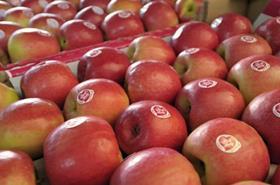
Australian apple exports are on track to reach 5,200 tonnes for 2016, which would be the highest result since 2006 according to Fresh Intelligence’s analysis of data from the Australian Bureau of Statistics (ABS) to November 2016. The result confirms a turn-around from the low base in 2014 of less than 2,000 tonnes as the industry seeks to redevelop export trade.
The UK topped the list of importers of Australian apples, with 1,300 tonnes of Pink Lady exported to premium retailers during August and September. This was the best result for apple exports to the UK since 2006 and 90 per cent above last year. Part of this may be attributed to the lower imports from other sources, the devaluation of the British pound following the Brexit vote in addition to the strong support for Pink Lady apple promotions run by Coregeo, a UK-based wholly owned subsidiary of APAL.
However, APAL’s focus on export development has been in the Asian markets, which has seen mixed results. India, Thailand and Taiwan are the largest apple importers in Asia each importing between 150,000 – 200,000 tonnes each, yet Australia’s trade to these markets were 62 tonnes, 236 tonnes and 23 tonnes respectively. In perspective, Australia remains a small player and must compete with China, New Zealand, Chile and the US, who supply the bulk of apple imports to these markets.
Importantly, these markets, along with Singapore and Malaysia have limited apple production due to their tropical climates and are more reliant on imports for their needs. Market access for Australia's mainland producersremains an impediment to developing trade, particularly in Taiwan, while competitive pricing and servicing remains a challenge when competing with export focused suppliers such as New Zealand and Chile, or the sheer scale of China.
Direct trade to China, almost all from Tasmania, dropped from 204 tonnes in 2015 to 79 tonnes in 2016. China produces over 40m tonnes of apples each year, and exported over 1.1m tonnes in 2016, mostly to other Asian markets that are in Australia’s sights. Imports by China were around 70,000 tonnes in 2016 with the US, New Zealand and Chile supplying some 93 per cent of the apples imported. Australia’s market development in China has been focused on the premium online distribution channels rather than traditional wet markets or retail chains. Australian apple exports to Hong Kong lifted 50 per cent to 304 tonnes.
Other highlights were exports to Indonesia lifting 176 per cent to 634 tonnes, recovering most of the trade lost in the past three years with the import condition issues. Malaysia also doubled to 261 tonnes and the UAE, a newer market for Australia, also doubled to 410 tonnes.
Indonesia drives pear trade
Increased demand from Indonesia was the key driver for Australian pear exports in 2016. Trade increased over 70 per cent making Indonesia the clear number one destination, importing 4,200 tonnes or a 40 per cent share of Australian pear exports. Evidence from the increased demand for European pears from several Asian markets, including China, is giving resurgence for the European style pears in markets dominated by Asian style pears.
The traditional key markets of New Zealand and Canada dipped over 20 per cent each to 2,215 and 998 tonnes respectively, which meant that the overall export result was 3 per cent lower than 2015 at 10,056 tonnes, based on Fresh Intelligence’s analysis of ABS results to November 2016.
Limited stocks may have contributed to a slower rate of exports since July, as the trend was strongly higher until that stage, again with Indonesia leading.
It is worth noting that the demand for European style pears by China, mostly from the US, Europe and New Zealand, has lifted to 8,000 tonnes from virtually zero trade in 2010. Although Australia does not have access to the China market, the trends suggest some opportunities may be there.



